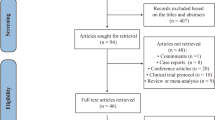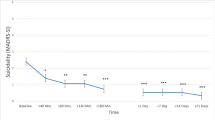Abstract
The role of melancholic features on the antisuicidal effect of 0.5 mg/kg ketamine infusion has remained unclear in patients with treatment-resistant depression (TRD) and strong suicidal ideation (SI). Whether ketamine diminishes suicidal ideation in patients with TRD-SI was also unknown. We enrolled 84 patients with TRD-SI, including 27 with melancholic features and 57 without, and then randomly administered a single infusion of 0.5 mg/kg ketamine or 0.045 mg/kg midazolam. The clinician-rated Montgomery–Åsberg Depression Rating Scale (MADRS) item 10, Columbia Suicide Severity Rating Scale–Ideation Severity Subscale (CSSRS-ISS), and self-reported Positive and Negative Suicide Ideation Inventory (PANSI) were used to assess suicidal symptoms from baseline to day 7. Generalized estimating equation models showed that only patients without melancholic features (MADRS item 10: infusion group effect, p = 0.017; CSSRS-ISS: infusion group × time effect, p = 0.008; PANSI-negative suicidal ideation: infusion group effect, p = 0.028) benefited from the antisuicidal effect of low-dose ketamine. The PANSI-positive ideation scores were higher in the ketamine group than in the midazolam group (p = 0.038) for patients with melancholic features. Additional studies are necessary to clarify the neuromechanisms underlying the ketamine-related positive effect against SI and antisuicidal effects among patients with TRD-SI. Additional studies are necessary to clarify the neuromechanisms underlying the ketamine-related positive effect against SI and antisuicidal effects among patients with TRD-SI.



Similar content being viewed by others
References
Knipe D, Padmanathan P, Newton-Howes G, Chan LF, Kapur N (2022) Suicide and self-harm. Lancet 399(10338):1903–1916
Liu RT, Walsh RFL, Sheehan AE, Cheek SM, Sanzari CM (2022) Prevalence and correlates of suicide and nonsuicidal self-injury in children: a systematic review and meta-analysis. JAMA Psychiat. https://doi.org/10.1001/jamapsychiatry.2022.1256
Turecki G, Brent DA (2016) Suicide and suicidal behaviour. Lancet 387(10024):1227–1239
Fu TS, Lee CS, Gunnell D, Lee WC, Cheng AT (2013) Changing trends in the prevalence of common mental disorders in Taiwan: a 20-year repeated cross-sectional survey. Lancet 381(9862):235–241
Chang YH, Lin CY, Liao SC, Chen YY, Shaw FF, Hsu CY et al (2022) Societal factors and psychological distress indicators associated with the recent rise in youth suicide in Taiwan: a time trend analysis. Aust N Z J Psychiatry. https://doi.org/10.1177/00048674221108640
Abbar M, Demattei C, El-Hage W, Llorca PM, Samalin L, Demaricourt P et al (2022) Ketamine for the acute treatment of severe suicidal ideation: double blind, randomised placebo controlled trial. BMJ 376:e067194
Price RB, Kissel N, Baumeister A, Rohac R, Woody ML, Ballard ED et al (2022) International pooled patient-level meta-analysis of ketamine infusion for depression: in search of clinical moderators. Mol Psychiatry. https://doi.org/10.1038/s41380-022-01757-7
Kritzer MD, Mischel NA, Young JR, Lai CS, Masand PS, Szabo ST et al (2022) Ketamine for treatment of mood disorders and suicidality: a narrative review of recent progress. Ann Clin Psychiatry 34(1):33–43
Evers AG, Murrough JW, Charney DS, Costi S (2022) Ketamine as a prophylactic resilience-enhancing agent. Front Psych 13:833259
Brachman RA, McGowan JC, Perusini JN, Lim SC, Pham TH, Faye C et al (2016) Ketamine as a prophylactic against stress-induced depressive-like behavior. Biol Psychiat 79(9):776–786
DePierro J, Lepow L, Feder A, Yehuda R (2019) Translating molecular and neuroendocrine findings in posttraumatic stress disorder and resilience to novel therapies. Biol Psychiat 86(6):454–463
Holman MS, Williams MN (2022) Suicide risk and protective factors: a network approach. Arch Suicide Res 26(1):137–154
Wang C, Zhou Y, Zheng W, Liu W, Zhan Y, Li H et al (2019) Association between depression subtypes and response to repeated-dose intravenous ketamine. Acta Psychiatr Scand 140(5):446–457
Dold M, Bartova L, Fugger G, Kautzky A, Souery D, Mendlewicz J et al (2018) Major depression and the degree of suicidality: results of the European Group for the Study of Resistant Depression (GSRD). Int J Neuropsychopharmacol 21(6):539–549
Su TP, Li CT, Lin WC, Wu HJ, Tsai SJ, Bai YM et al (2023) A randomized double-blind midazolam-controlled trial of low-dose ketamine infusion in patients with treatment-resistant depression and prominent suicidal ideation. Int J Neuropsychopharmacol. https://doi.org/10.1093/ijnp/pyad014
Su TP, Chen MH, Li CT, Lin WC, Hong CJ, Gueorguieva R et al (2017) Dose-related effects of adjunctive ketamine in Taiwanese patients with treatment-resistant depression. Neuropsychopharmacology 42(13):2482–2492
Carmody TJ, Rush AJ, Bernstein I, Warden D, Brannan S, Burnham D et al (2006) The Montgomery Asberg and the Hamilton ratings of depression: a comparison of measures. Eur Neuropsychopharmacol 16(8):601–611
Grunebaum MF, Galfalvy HC, Choo TH, Keilp JG, Moitra VK, Parris MS et al (2018) Ketamine for rapid reduction of suicidal thoughts in major depression: a midazolam-controlled randomized clinical trial. Am J Psychiatry 175(4):327–335
Murrough JW, Iosifescu DV, Chang LC, Al Jurdi RK, Green CE, Perez AM et al (2013) Antidepressant efficacy of ketamine in treatment-resistant major depression: a two-site randomized controlled trial. Am J Psychiatry 170(10):1134–1142
Osman A, Gutierrez PM, Kopper BA, Barrios FX, Chiros CE (1998) The positive and negative suicide ideation inventory: development and validation. Psychol Rep 82(3 Pt 1):783–793
Wilkinson ST, Ballard ED, Bloch MH, Mathew SJ, Murrough JW, Feder A et al (2018) The effect of a single dose of intravenous ketamine on suicidal ideation: a systematic review and individual participant data meta-analysis. Am J Psychiatry 175(2):150–158
Fekadu A, Wooderson SC, Markopoulou K, Cleare AJ (2009) The Maudsley Staging Method for treatment-resistant depression: prediction of longer-term outcome and persistence of symptoms. J Clin Psychiatry 70(7):952–957
Bech P, Gram L, Dein E, Jacobsen O, Vitger J, Bolwig T (1975) Quantitative rating of depressive states: correlation between clinical assessment, Beck’s self-rating scale and Hamilton’s objective rating scale. Acta Psychiatr Scand 51(3):161–170
PrimodeCarvalho Alves L, PiodeAlmeida Fleck M, Boni A, Sicada RN (2017) The major depressive disorder hierarchy: Rasch analysis of 6 items of the Hamilton depression scale covering the continuum of depressive syndrome. PLoS ONE 12(1):e0170000
Østergaard SD, Bech P, Trivedi MH, Wisniewski SR, Rush AJ, Fava M (2014) Brief, unidimensional melancholia rating scales are highly sensitive to the effect of citalopram and may have biological validity: implications for the research domain criteria (RDoC). J Affect Disord 163:18–24
Grunebaum MF, Galfalvy HC, Oquendo MA, Burke AK, Mann JJ (2004) Melancholia and the probability and lethality of suicide attempts. Br J Psychiatry 184:534–535
Weissman CR, Hadas I, Yu D, Jones B, Kong D, Mulsant BH et al (2021) Predictors of change in suicidal ideation across treatment phases of major depressive disorder: analysis of the STAR*D data. Neuropsychopharmacology 46(7):1293–1299
Zisook S, Trivedi MH, Warden D, Lebowitz B, Thase ME, Stewart JW et al (2009) Clinical correlates of the worsening or emergence of suicidal ideation during SSRI treatment of depression: an examination of citalopram in the STAR*D study. J Affect Disord 117(1–2):63–73
Chen MH, Lin WC, Wu HJ, Bai YM, Li CT, Tsai SJ et al (2020) Happiness during low-dose ketamine infusion predicts treatment response: reexploring the adjunctive ketamine study of Taiwanese patients with treatment-resistant depression. J Clin Psychiatry. https://doi.org/10.4088/JCP.20m13232
Gaydos SJ, Kelley AM, Grandizio CM, Athy JR, Walters PL (2015) Comparison of the effects of ketamine and morphine on performance of representative military tasks. J Emerg Med 48(3):313–324
Dwivedi Y (2010) Brain-derived neurotrophic factor and suicide pathogenesis. Ann Med 42(2):87–96
Sonal A, Raghavan V (2018) Brain derived neurotrophic factor (BDNF) and suicidal behavior: a review of studies from Asian countries. Asian J Psychiatr 33:128–132
Kudinova AY, Deak T, Deak MM, Gibb BE (2019) Circulating levels of brain-derived neurotrophic factor and history of suicide attempts in women. Suicide Life Threat Behav 49(1):54–63
Karege F, Vaudan G, Schwald M, Perroud N, La Harpe R (2005) Neurotrophin levels in postmortem brains of suicide victims and the effects of antemortem diagnosis and psychotropic drugs. Brain Res Mol Brain Res 136(1–2):29–37
Kavalali ET, Monteggia LM (2012) Synaptic mechanisms underlying rapid antidepressant action of ketamine. Am J Psychiatry 169(11):1150–1156
Zanos P, Gould TD (2018) Mechanisms of ketamine action as an antidepressant. Mol Psychiatry 23(4):801–811
Taliaz D, Loya A, Gersner R, Haramati S, Chen A, Zangen A (2011) Resilience to chronic stress is mediated by hippocampal brain-derived neurotrophic factor. J Neurosci 31(12):4475–4483
Acknowledgements
The authors thank all research assistants, physicians, pharmacist and nursing staffs at D020 Unit of Department of Psychiatry, Taipei Veterans General Hospital and at Department of Psychiatry, Cheng Hsin General Hospital for their assistance during the study process, without whom this work could have been possible. We thank Mr I-Fan Hu for his support and friendship.
Funding
The study was supported by grant from Taipei Veterans General Hospital (V111C-010, V111C-040, V111C-029, V112C-033), Yen Tjing Ling Medical Foundation (CI-109–21, CI-109–22, CI-110–30), Kun-Po Soo Medical Foundation, Ministry of Science and Technology, Taiwan (MOST110-2314-B-075–026, MOST110-2314-B-075–024 -MY3, MOST 109–2314-B-010–050-MY3, MOST111-2314-B-075 -014 -MY2, MOST 111–2314-B-075 -013), Taipei, Taichung, Kaohsiung Veterans General Hospital, Tri-Service General Hospital, Academia Sinica Joint Research Program (VTA112-V1-6–1) and Veterans General Hospitals and University System of Taiwan Joint Research Program (VGHUST112-G1-8–1). The funding source had no role in any process of our study.
Author information
Authors and Affiliations
Corresponding author
Ethics declarations
Conflict of interest
None of the authors in this study had any conflict of interest to declare.
Supplementary Information
Below is the link to the electronic supplementary material.
Rights and permissions
Springer Nature or its licensor (e.g. a society or other partner) holds exclusive rights to this article under a publishing agreement with the author(s) or other rightsholder(s); author self-archiving of the accepted manuscript version of this article is solely governed by the terms of such publishing agreement and applicable law.
About this article
Cite this article
Chen, MH., Su, TP., Li, CT. et al. Effects of melancholic features on positive and negative suicidal ideation in patients with treatment-resistant depression and strong suicidal ideation receiving low-dose ketamine infusion. Eur Arch Psychiatry Clin Neurosci (2023). https://doi.org/10.1007/s00406-023-01735-2
Received:
Accepted:
Published:
DOI: https://doi.org/10.1007/s00406-023-01735-2




